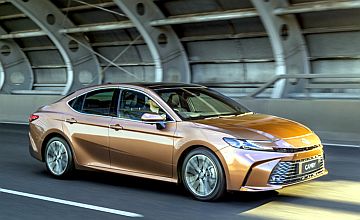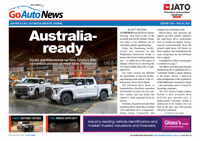Make / Model Search
OptionsCar reviews - Toyota - CamryToyota modelsOverviewWe like More powerful and efficient hybrid driveline; spacious interior and boot; improved roadholding; thoughtful and easy-to-use human-machine interface; comfortable seating position Room for improvement Significant price increases highlighted by removal of SX grade; steering feel falls short of Euro rivals; Aussie range omits US-spec trim and specification highlights including AWD Seventh generation Camry a “very significant upgrade”26 Sep 2024 By MATT BROGAN Overview
TOYOTA has launched its seventh-generation Camry into Australian dealerships this week, the three-variant and all-hybrid mid-sized sedan arriving as a major facelift of the outgoing model, with Toyota’s fifth-generation hybrid driveline technology joining freshened looks, a refined chassis, revised technology and the latest safety equipment (backed by a five-star ANCAP safety rating).
Pricing increases to reflect what can best be described as a “very significant upgrade”, the 2025 Toyota Camry carrying over the same platform as its predecessor, familiar front-door architecture and very little else.
The range now begins from $39,990 plus on-road costs in base Ascent form, rising through $42,990 + ORC for the Ascent Sport and $53,990 + ORC for the flagship SL.
The pricing represents a $4939 increase over the entry price of the outgoing (petrol-powered) Ascent and a $2073 increase over the sixth-generation Ascent Hybrid. The Ascent Sport Hybrid grade increases by $2273 and the SL $2573. The Camry SX Hybrid is deleted from the range.
Toyota’s strong selling Camry continues to vie with the exxy Honda Accord (from $57,900 drive-away), single-variant Hyundai Sonata N-Line (from $55,500 + ORC), dated Mazda 6 (from $36,290 + ORC), and Skoda Octavia (from $42,490 drive-away) – and remains Australia’s best-selling Medium passenger car.
Powering the range, Toyota’s 2.5-litre petrol-electric driveline delivers what it claims are improvements in driveability and fuel efficiency, shaving up to 11 per cent from the fuel bill of the outgoing model. The official Combined cycle number is listed at 4.0 litres per 100km with CO2 emissions of 91 grams per kilometre.
Total system power increases by 10kW to 170kW when compared with the outgoing Camry, generated through the combination of a 138kW/221Nm four-cylinder petrol engine and 100kW/208Nm permanent magnet synchronous motor – both driving the front wheels via a continuously variable transmission.
Ride and handling improvements arrive courtesy of retuned MacPherson strut front and multi-link rear suspension to provide what Toyota says are “more engaging handling characteristics, without affecting ride comfort”.
The electric steering rack has likewise been retuned with speed-sensitive assistance providing a “lighter and more direct steering feel and responsiveness”, says Toyota. The setup is accompanied by a newly developed electric brake control system that employs an active hydraulic booster to enhance brake feel and optimise kinetic energy recovery.
While the new Camry sits on the same TNGA-K platform as its predecessor, with an identical 2825mm wheelbase, the car’s exterior makeover has resulted in a longer front overhang, extending the car’s overall length by 35mm when compared with its predecessor.
The front and rear styling is defined by Toyota’s bold Hammer Head design concept with its functional and stylish aerodynamic elements, while in profile the character lines that converge at the rear, along with a more tapered rear roofline, give the new Camry a “distinctively dynamic appearance”.
The new-look design continues inside with what the importer says is a “sophisticated cabin featuring a sculpted dash and door trims that create a seamless flow”.
Interior highlights include digital instrumentation displayed on either 7.0-inch or 12.3-inch screens, depending on the grade, Toyota’s latest-generation multimedia system featuring cloud-based satellite navigation, Bluetooth connectivity and wireless Apple CarPlay and Android Auto, with either 8.0-inch or 12.3-inch touchscreen infotainment displays, again depending on grade.
Feature and equipment highlights for the entry-grade Ascent include 17-inch alloy wheels, cloth upholstery, dual-zone climate control and LED daytime running, head- and tail-lights.
The mid-range Ascent Sport adds high-grade LED lighting and LED fog lights, an eight-way power adjustable driver’s seat with lumbar support, wireless smartphone charger and a larger 12.3-inch multimedia touchscreen display.
Finally, the flagship SL is differentiated by 18-inch alloy wheels, rain-sensing wipers, rear side and back privacy glass and heated side mirrors with reverse and memory function.
Inside, Camry SL features leather-accented upholstery, a panoramic sunroof, eight-way power adjustable front passenger seat, front seat heating and ventilation, a heated steering wheel with power adjustment and a nine-speaker JBL audio system.
Across the range we also find the latest safety kit applied with the new Camry boasting the full suite of Toyota’s Safety Sense active safety technologies.
Upgrades for the new Camry include improved road user detection and active cruise control parameters and the addition of new functionality across the range including blind spot monitor, rear cross traffic alert, emergency driver support system and safe exit assist.
The new Camry is offered with a 12-month complimentary subscription to Toyota Connected Services providing what Toyota says is a “range of welcome benefits to customers through the Camry’s inbuilt data communication module”.
Toyota backs the Camry range with a five-year/unlimited-kilometre guarantee including five years of capped-price servicing, spread over 12-month or 15,000km intervals at a price of $255 per service.
The new-generation Camry range is available with the choice of eight exterior colours consisting of Eclipse Black, Frosted White, Glacier White, Jasper Red, Liquid Mercury, Precious Bronze, Saturn Blue, and Silver Pearl.
Driving Impressions
Sedan buyers seem to face a shrinking market with each passing year; and with SUV sales towering over those of the humble four-door it’s hardly surprising.
But the good news is that sedan buyers have some brilliant options available in the Aussie market, not least of all the new Toyota Camry.
Camry and brilliant in the same sentence, I hear you ask. Unequivocally, yes. In short, the Camry is a terrific drive bolstered by improved handling, a strong yet efficient driveline, more spacious cabin, and polished human-machine interface.
If that’s not enough, it also offers some of the best ADAS technologies we’re yet to experience – and just how many vehicles have you heard us say that about in recent times?
On the road, it feels like Camry has torn off the cardigan and donned a Lycra body suit. It has plentiful power – especially for overtaking – delivered smoothly to the front wheels. The on-off sensation of the petrol-electric swap-over is a thing of the past, the refined action of the 2.5-litre engine an impressive addition to the latest round of changes.
What’s more impressive is that the Camry delivers this power efficiently. Without trying, and with the dual-zone climate zone in operation, we managed an impressive average of 2.9 litres per 100km on the highway-biased launch drive. Part of us would dearly love to take the Camry on an efficiency run and see just what it’s capable of, but a sub-three-litre result is nothing to sniff at.
The improved suspension package shines on twisty, pockmarked country roads, the smaller wheel and tyre combination adding to a comfortable ride that suits the vehicle’s orientation to a tee. Sure, it might lack the overtly direct steering of its European competitors (think Skoda Octavia), but with so many Camrys doing duty in the rideshare business we think the setup might be just the ticket.
The Camry is impressively easy to manoeuvre and park, the resolution of the camera system welcomed in close-confine situations. Unlike other hybrids we’ve sampled in recent times, the Camry is also quick to change from Reverse to Drive (or vice-versa), which is handy for those times the turning circle isn’t quite tight enough.
Road noise and cabin comfort is a highlight, with the Camry bordering on Lexus ES levels of hush. Sure, the engine can be a little raspy when pushed and there is a flourish of wind noise from the wing mirrors, but for a $40K car we think the balance is exceptional. Again, not a word you’d typically associate with a Toyota Camry…
Toyota also appears to have nailed the mix of hard buttons and touchscreen tabs. Everything you need in regular use is handy to the touch, while the on-screen menus offer a considered alternative for features you might use only once or twice a day. The HMI is easy to navigate and offers sufficient personalisation for just about any user.
Private buyers will love the SL variant’s nine-speaker audio system – even if the step up to the model is a little on the pricey side.
As is typical of Toyota models, the Camry’s HVAC system did well to manage a stable cabin temperature. We’ve found many climate control systems tend to let the temperature slide before making a large (and often noisy) correction, but not the Camry’s. Yes, sometimes it’s the little things that make all the difference.
For us, another of those ‘little things’ is the well-proportioned brake pedal. The sudden change in vacuum pressure created when switching from petrol to electric power has plagued the pedal feel of Camry’s past, often creating a jerky stop for passengers. The new system alleviates that issue, providing a progressive and well-metered pedal that offers effortless chauffer-smooth stops. Uber drivers, you’re on notice – there are no more excuses for improper stops.
While the ‘Aussie’ Camry mightn’t get all the bells and whistles from overseas, it is still a brilliant car for the money and offers both the on-road and aftersales goods to ensure a long and happy ownership experience.
If you’re not a fan of SUVs and have previously thought of the Camry as ‘too pedestrian’, then get to a Toyota dealership and take a test drive for yourself. We think you’ll be just as impressed as we are.
 Read more23rd of September 2024  Market Insight: ‘A beautiful set of numbers’While RAV4 tops sales charts, Toyota’s Camry is setting its own passenger car records19th of September 2024  Top safety marks for new Toyota CamryRecord high scores see Toyota Camry blitz latest ANCAP safety assessment16th of September 2024  Toyota’s seventh-generation Camry arrives……but how much of this ‘new’ mid-sized sedan is carried over from the outgoing model?All car reviews Alfa Romeo Alfa Romeo Abarth Abarth Alpine Alpine Alpina Alpina Audi Audi Aston Martin Aston Martin BMW BMW Bentley Bentley Chevrolet Chevrolet Chery Chery Citroen Citroen Chrysler Chrysler Dodge Dodge Cupra Cupra Ferrari Ferrari DS DS Ford Ford Fiat Fiat FPV FPV Foton Foton GWM GWM Great Wall Great Wall Holden Holden Haval Haval HSV HSV Honda Honda Hyundai Hyundai Hummer Hummer Isuzu Isuzu Infiniti Infiniti Jeep Jeep Jaguar Jaguar Lamborghini Lamborghini Kia Kia LDV LDV Land Rover Land Rover Lotus Lotus Lexus Lexus Maserati Maserati Mahindra Mahindra McLaren McLaren Mazda Mazda Mercedes-Benz Mercedes-Benz Mercedes-AMG Mercedes-AMG Mini Mini MG MG Nissan Nissan Mitsubishi Mitsubishi Peugeot Peugeot Opel Opel Proton Proton Porsche Porsche Renault Renault Ram Ram Rover Rover Rolls-Royce Rolls-Royce Skoda Skoda Saab Saab SsangYong SsangYong Smart Smart Suzuki Suzuki Subaru Subaru Toyota Toyota Tesla Tesla Volvo Volvo |
OptionsClick to share
|











Facebook Twitter Instagram